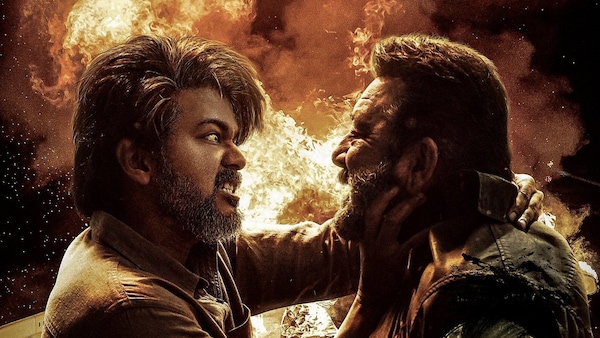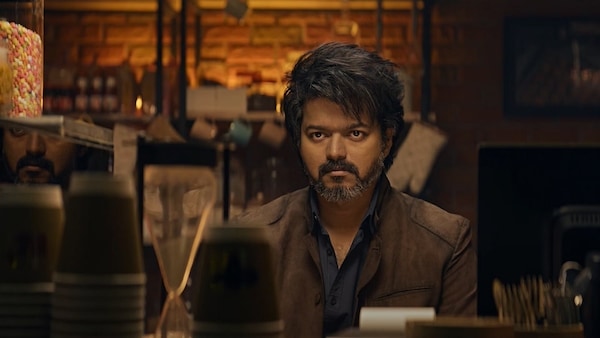Vijay's Leo & Lokesh Kanagaraj’s History Of Violence
Lokesh crafts something that’s formally inventive and narratively fluid in the first half of Leo. Sadly, he can't sustain it in the second. Aditya Shrikrishna writes.

Last Updated: 07.22 PM, Oct 19, 2023
This column was originally published as part of our newsletter The Daily Show on October 19, 2023. Subscribe here. (We're awesome about not spamming your inbox!)
***
Lokesh Kanagaraj usually doesn’t take things slow but in his latest film Leo—written by him, Rathna Kumar and Deeraj Vaidy—the beginnings are gradual. They are not eventless, but are character driven, giving us a peek into Parthiban’s (Vijay) life in Himachal Pradesh. He owns a café called Wild Beans (wink), lives with his wife Sathya (Trisha Krishnan) and two kids—a teenage son Siddhu (Mathew Thomas) and a younger daughter. But before all this there is Lokesh’s characteristic prologue. The opening credits claim tribute to A History of Violence and there are many parallels, inspirations and recreations. Considering David Cronenberg’s adaptation and not the graphic novel, let’s say while the film was minimalist, Lokesh goes for the explosive. But he knows that difference and therefore the muted start to Leo. In Leo, like in A History of Violence, the family is paramount. One loves and protects. The other hates and kills. There are spoilers ahead but if you know your A History of Violence, you know most of it.

A criminal gang commits murder and other atrocities, flees and is left to fend for themselves with no money in their pocket. A hyena goes astray in broad daylight and wreaks havoc in a public space. Parthiban, seemingly trained to handle wild beasts (wink) and conveniently friends with forest officer Joshy (Gautham Vasudev Menon), comes to the rescue and brings it under control. This is clever. It establishes both Parthiban and Joshy’s familiar terrain and gives Parthiban a different shade than we’d imagine a mainstream star like Vijay in—yes, he is a café owner, but he can handle wild animals (with help from javelin throwing son and Joshy—these are all hat tips to A History of Violence) and that doesn’t mean he can take on heavily armed goons. We cannot straight away see Vijay save patrons and employees in his café like Joey Cusack does in Cronenberg’s film. Maybe knowing Vijay’s on screen persona, we might have bought into it, but Lokesh wants to establish a certain distance between us and Parthiban—he is not who we think he is. Or is he? Not yet at least. It’s like pulling two rugs from under the audience in one slow motion. Even Vijay’s introduction is silent, we only see his eyes and Lokesh betrays a secretive bond between father and son that gets a nice callback later. Leo is full of such callbacks. After all, Leo himself is a callback for Parthiban.

Almost everything comes back to bite Parthiban and so does a moral quandary he narrates to his kids. Lokesh plays to his strengths once the gang encounters Parthiban. There are our old Tamil film songs and Vijay sitting in a what-have-I-done pose, one like how he sits inside the jail in Master. But the thrill is in what comes before that. No one does action like the combination of Lokesh and Anbariv today in India. There are two great things about Leo—one is the writing in the first half, how one event informs another, and everything snowballs into an avalanche (there is delightful use of several Chekhov’s guns) all the way till three quarters into the film. The introduction of the Das brothers (Sanjay Dutt and Arjun) intercut with Parthiban’s cagey, vigilant glare is a great interval point, once again Lokesh choosing to go muted. The other is the hand-to-hand combat and fight sequences. There is spatial coherence and continuity to these shots, and we know who is hitting whom and what they are going to use to hit them with is a mystery in microsecond—like the tissue holder in the café. We know the complete map of the area they are operating in; we can tell what Parthiban will face when he turns to his right. There are two ambitious shots in the second half that probably sounded great as ideas—a chase that’s more a gasp than hold-on-for-your-dear-life and a bird’s eye view single take of chaos in a warehouse. Both these scenes cannot hold a candle to the burst of violence in Parthiban’s café and the fight scene in the market. The cuts aren’t as quick as usual, the camera roves around the two men sparring and waits till the punch lands. Easily the most joyous parts of Leo.
Where Lokesh lets us down is a terribly fleshed out flashback and a whimper before an explosive climax. The smoothness (introducing George Maryan’s Napoleon is genius sleight of hand) of the first half’s writing is missing here. It’s clear the makers wanted to avoid something like Baasha and many other films with this one-line plot. But who cares about plots repeating? All that matters is the treatment and with the first hour, Lokesh is winsome in crafting something that’s formally inventive and narratively fluid. But the second half goes back to the inconsistency of Master which remains Lokesh’s weakest film even after Leo. Goosebumps inducing high points scattered all over but a flabby mess that must have been crumpled and tossed into the bin. It’s almost like both the flashback and the song were unnecessary. Leo’s myth was long established with what people say about him, there was no reason why we must witness inferior versions of it. What Lokesh does get right here is how he extends Parthiban’s I-am-not-Leo plea as long as possible. Leo will meet his family only on his terms. He will make them dance to his tunes, not otherwise. As for Madonna Sebastian? Well, let’s just say this Madonna cannot dance.

 Premium
Premium